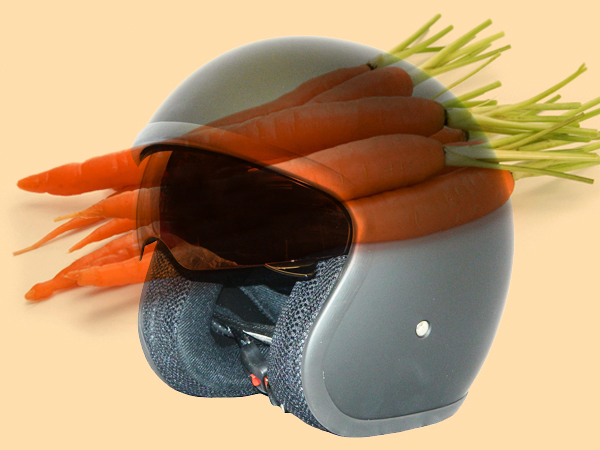Safe motorcycle helmets – made of carrot fibers?

Motorcycle helmets made of plant fibers from the production of carrot juice? Empa researchers analyze whether this kind of production makes sense from an ecological and economical perspective. Empa
All over the world, research is being conducted into biodegradable and recyclable synthetics. However, fiber-reinforced components remain problematic – if glass or carbon fibers are used.
Within the scope of an EU research project, the Scottish company Cellucomp Limited has now developed a method to obtain nanofibers from carrot waste. These fibers would be both cost-effective and biodegradable. However, is the method, which works in the lab, also marketable on a large scale?
An MPAS (multi-perspective application selection) method developed at Empa helps identify the industrial sectors where new materials might be useful from a technical and economical perspective. At the same time, MPAS also considers the ecological aspect of these new materials. The result for our example: Nanofibers made of carrot waste might be used in the production of motorcycle helmets or side walls for motorhomes in the future.
Three-step analysis
In order to clarify a new material’s market potential, Empa researchers Fabiano Piccinno, Roland Hischier and Claudia Som proceed in three steps for the MPAS method. First of all, the field of possible applications is defined: Which applications come into question based on the technical properties and what categories can they be divided into? Can the new material replace an existing one?
The second step concerns the technical feasibility and market potential: Can the material properties required be achieved with the technical process? Might the product quality vary from one production batch to the next? Can the lab process be upgraded to an industrial scale cost-effectively? Is the material more suited to the low-cost sector or expensive luxury goods? And finally: Does the product meet the legal standards and the customers’ certification needs?
In the third step, the ecological aspect is eventually examined: Is this new material for the products identified really more environmentally friendly – once all the steps from product creation to recycling have been factored in? Which factors particularly need to be considered during production stage to manufacture the material in as environmentally friendly a way as possible?
Industrial production on a five-ton scale – calculated theoretically
The MPAS approach enables individual scenarios for a future production to be calculated with an extremely high degree of accuracy. In the case of the carrot waste nanofibers, for instance, it is crucial whether five tons of fresh carrots or only 209 kilograms of carrot waste (fiber waste from the juicing process) are used as the base material for their production.
The issue of whether the solvent is ultimately recycled or burned affects the production costs. And the energy balance depends on how the enzymes that loosen the fibers from the carrots are deactivated. In the lab, this takes place via heat; for production on an industrial level, the use of bleaching agents would be more cost-effective.
Conclusion: six possible applications for “carrot fibers“
For fiber production from carrot waste, the MPAS analysis identified six possible customer segments for the Scottish manufacturer Cellucomp that are worth taking a closer look at: Protective equipment and devices for recreational sport, special vehicles, furniture, luxury consumer goods and industrial manufacturing.
The researchers listed the following examples: Motorcycle helmets and surfboards, side walls for motorhomes, dining tables, high-end loudspeaker boxes and product protection mats for marble-working businesses. Similarly detailed analyses can also be conducted for other renewable materials – before a lot of money is actually invested in production plants.
Media Contact
All latest news from the category: Innovative Products
Newest articles
Faster, more energy-efficient way to manufacture an industrially important chemical
Zirconium combined with silicon nitride enhances the conversion of propane — present in natural gas — needed to create in-demand plastic, polypropylene. Polypropylene is a common type of plastic found…

Energy planning in Ghana as a role model for the world
Improving the resilience of energy systems in the Global South. What criteria should we use to better plan for resilient energy systems? How do socio-economic, technical and climate change related…

Artificial blood vessels could improve heart bypass outcomes
Artificial blood vessels could improve heart bypass outcomes. 3D-printed blood vessels, which closely mimic the properties of human veins, could transform the treatment of cardiovascular diseases. Strong, flexible, gel-like tubes…





















